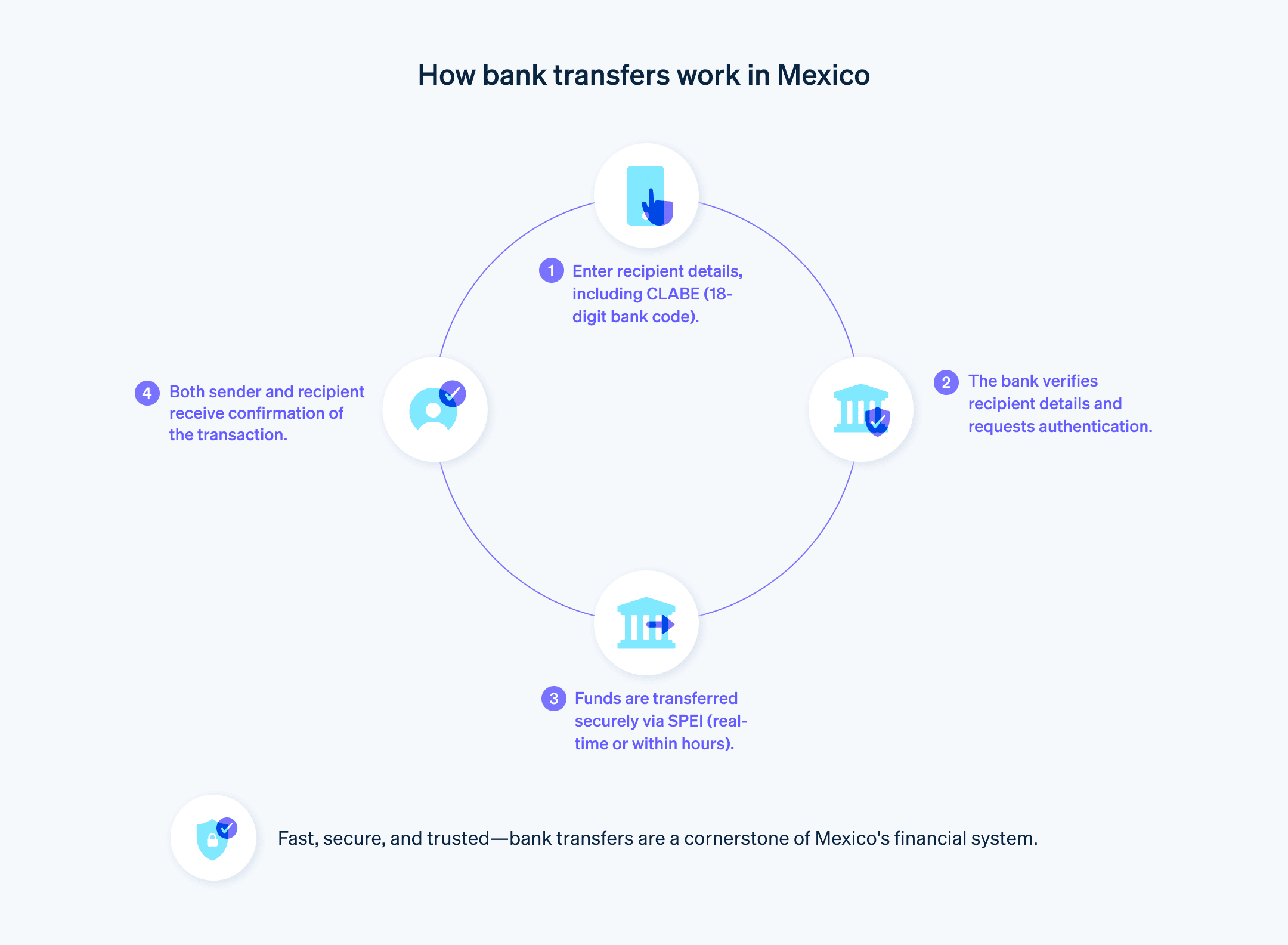การโอนเงินผ่านธนาคารในเม็กซิโกเป็นแง่มุมที่สําคัญของภาคการเงินโดยเฉพาะอย่างยิ่งสําหรับธุรกิจ ผู้ใช้มักชอบใช้วิธีกาชำระเงินนี้เนื่องจากมีความเสถียรและความไว้วางใจระดับสูงของธุรกิจและลูกค้า
การโอนเงินผ่านธนาคารเริ่มได้รับความนิยมมากขึ้นในเม็กซิโก โดยเติบโตขึ้น 60% ตั้งแต่ปี 2020 ถึง 2022 สาเหตุมาจากการที่วิธีการนี้เป็นส่วนหนึ่งในการพัฒนาระบบดิจิทัลของบริการทางการเงิน และการที่ลูกค้าและธุรกิจต่างๆ เลือกแพลตฟอร์มออนไลน์เพื่อตอบโจทย์ความต้องการด้านธนาคาร การเปลี่ยนแปลงนี้ยังขับเคลื่อนด้วยภาคธุรกิจอีคอมเมิร์ซในเม็กซิโก ซึ่งการโอนเงินผ่านธนาคารเป็นตัวเลือกการชําระเงินที่สะดวกสําหรับการซื้อสินค้าออนไลน์
นอกจากนี้ สภาพแวดล้อมทางกฎหมายในเม็กซิโกก็มีบทบาทสําคัญในการกําหนดการใช้บริการโอนเงินผ่านธนาคาร โดยหน่วยงานกํากับดูแลทางการเงินและรัฐบาลได้นํากฎและแนวทางที่กํากับดูแลธุรกรรมเหล่านี้มาใช้ กฎระเบียบเหล่านี้ออกแบบมาเพื่อปกป้องลูกค้าและธุรกิจ เพื่อให้ธุรกรรมความปลอดภัยและเป็นไปตามกฎหมาย นอกจากนี้ กรอบข้อบังคับยังช่วยแก้ไขปัญหาต่างๆ เช่น การป้องกันการฉ้อโกงและการป้องกันข้อมูลได้ด้วย
ต่อไปนี้เป็นข้อมูลเกี่ยวกับสิ่งที่ธุรกิจต่างๆ จําเป็นต้องทราบเกี่ยวกับการโอนเงินผ่านธนาคารในเม็กซิโก ไม่ว่าจะเป็นวิธีการใช้งาน ค่าบริการ และสิ่งที่ธุรกิจต้องพิจารณาเมื่อรวมวิธีนี้ในกลยุทธ์การชําระเงิน
บทความนี้ให้ข้อมูลอะไรบ้าง
- ผู้ที่ใช้การโอนเงินผ่านธนาคารในเม็กซิโกคือใคร
- วิธีการทํางานของการโอนเงินผ่านธนาคารในเม็กซิโก
- Sistema de Pagos Electrónicos Interbancarios (SPEI) คืออะไร
- ธนาคารและสถาบันใดบ้างที่อํานวยความสะดวกในการโอนเงินผ่านธนาคารในเม็กซิโก
- ประโยชน์ที่ธุรกิจจะได้รับจากการยอมรับการโอนเงินผ่านธนาคารเข้าและออกจากเม็กซิโก
- มาตรการรักษาความปลอดภัยของการโอนเงินผ่านธนาคารในเม็กซิโก
- ข้อกําหนดสําหรับธุรกิจเพื่อเริ่มรับชําระเงินโอนผ่านธนาคารในเม็กซิโก
- ธุรกิจที่อยู่นอกประเทศต้องใช้บัญชีธนาคารในเม็กซิโกเพื่อรับเงินโอนผ่านธนาคารจากเม็กซิโกใช่หรือไม่
- ทางเลือกอื่นๆ นอกเหนือจากการโอนเงินผ่านธนาคารในเม็กซิโก
ผู้ที่ใช้การโอนเงินผ่านธนาคารในเม็กซิโกคือใคร
ธุรกิจประเภทต่างๆ ที่ใช้การโอนเงินผ่านธนาคารในเม็กซิโกนั้นคล้ายคลึงกับธุรกิจที่ใช้งานการโอนเงินวิธีนี้ในสหรัฐอเมริกา เนื่องจากธุรกิจเหล่านี้ต้องการรับประโยชน์แบบเดียวกัน ภาพรวมของธุรกิจที่มักจะใช้การโอนเงินผ่านธนาคารสําหรับธุรกรรมหลากหลายประเภทมีดังนี้
ธุรกิจอีคอมเมิร์ซ
แพลตฟอร์มอีคอมเมิร์ซในเม็กซิโกมักจะใช้การโอนเงินผ่านธนาคารสําหรับการชําระเงินของลูกค้า เนื่องจากเป็นวิธีที่ปลอดภัยและตรวจสอบติดตามได้ โดยจะมีประโยชน์เป็นพิเศษสําหรับธุรกรรมขนาดใหญ่ ลูกค้าที่ซื้อของออนไลน์มักเลือกใช้การโอนเงินผ่านธนาคารเป็นวิธีติดตามการใช้จ่ายที่สะดวก และรู้สึกมั่นใจในความปลอดภัยของข้อมูลทางการเงินองค์กรขนาดเล็กและขนาดกลาง (SME)
SME จํานวนมากในเม็กซิโกใช้การโอนเงินผ่านธนาคารสําหรับธุรกรรมแบบธุรกิจกับธุรกิจ (B2B) โดยธุรกิจเหล่านี้ได้รับประโยชน์จากความโปร่งใสและข้อได้เปรียบด้านการบันทึกข้อมูล วิธีนี้ยังช่วยให้ธุรกิจจัดการการเงินของตนได้ดีขึ้นด้วยการบันทึกข้อมูลที่ชัดเจนเกี่ยวกับการชําระเงินขาเข้าและขาออกฟรีแลนซ์และผู้รับจ้างอิสระ
บุคคลทั่วไปที่ทํางานอิสระ เช่น ฟรีแลนซ์ มักจะใช้การโอนเงินผ่านธนาคารเพื่อรับการชําระเงินจากลูกค้าทั้งในตลาดและต่างประเทศ วิธีนี้ช่วยให้ลูกค้าได้รับเงินจากบริการได้โดยตรงและเรียบง่ายธุรกรรมด้านอสังหาริมทรัพย์
สําหรับการซื้อและการเช่าทรัพย์สิน ผู้ใช้มักจะใช้การโอนเงินผ่านธนาคารเนื่องจากมียอดเงินรวมเป็นจำนวนมาก ทั้งบุคคลทั่วไปและบริษัทอสังหาริมทรัพย์เลือกใช้วิธีการชำระเงินนี้ เนื่องจากมีความปลอดภัยและความสามารถในการโอนเงินจํานวนมากอย่างมีประสิทธิภาพการชําระเงินค่าสาธารณูปโภคและบริการ
คนจำนวนมากในเม็กซิโกใช้การโอนเงินผ่านธนาคารเพื่อชําระค่าสาธารณูปโภคและบริการ วิธีนี้สะดวกสําหรับการชําระเงินตามแบบแผนล่วงหน้า ช่วยให้ลูกค้าทําธุรกรรมโดยอัตโนมัติและหลีกเลี่ยงการขาดชําระเงินได้ธุรกรรมต่างประเทศ
ธุรกิจที่เข้าถึงลูกค้าทั่วโลกมักใช้การโอนเงินผ่านธนาคารเพื่อการค้าระหว่างประเทศ โดยยอมรับการชําระเงินได้อย่างกว้างขวาง สามารถรองรับได้หลายสกุลเงิน ทำให้วิธีการชำระเงินนี้มีความน่าเชื่อถือด้านการรับการชําระเงินข้ามพรมแดนการจ่ายเดือน
บริษัทมักจะใช้การโอนเงินผ่านธนาคารเพื่อจ่ายเงินเดือนให้พนักงาน ระบบจะโอนเงินเข้าบัญชีธนาคารของพนักงานได้โดยตรงและปลอดภัย ซึ่งสะดวกทั้งสําหรับนายจ้างและพนักงานการซื้อปลีกที่มีมูลค่าสูง
ลูกค้าหลายรายชอบใช้การโอนเงินผ่านธนาคารเพื่อซื้อสินค้าที่มีมูลค่าสูง เช่น อุปกรณ์อิเล็กทรอนิกส์หรือเฟอร์นิเจอร์ ซึ่งวิธีการชำระเงินนี้มีความน่าเชื่อถือมากกว่าวิธีอื่นๆ ที่อาจกําหนดวงเงินในการซื้อ
วิธีการทํางานของการโอนเงินผ่านธนาคารในเม็กซิโก
การโอนเงินผ่านธนาคารสามารถทำได้ผ่านกระบวนการที่กำหนดไว้อย่างรัดกุม ซึ่งตอบโจทย์ทั้งบุคคลทั่วไปและธุรกิจ ข้อมูลการทำงานโดยละเอียดมีดังนี้
การเริ่มต้นการโอนเงิน
ผู้ใช้ทั้งบุคคลทั่วไปหรือตัวแทนธุรกิจจะเริ่มต้นจากการเข้าสู่ระบบแพลตฟอร์มออนไลน์ของธนาคารหรือเดินทางไปที่สาขา จากนั้นต้องระบุรายละเอียดธนาคารซึ่งปกติแล้วจะประกอบด้วยหมายเลขบัญชีและ Clave Bancaria Estandarizada (หรือ CLABE) ซึ่งเป็นรหัสธนาคาร 18 หลักตามมาตรฐานในเม็กซิโก) สําหรับการโอนเงินระหว่างประเทศ โดยปกติแล้วต้องระบุข้อมูลเพิ่มเติม เช่น รหัส SWIFT/BICขั้นตอนการยืนยัน
ธนาคารจะยืนยันรายละเอียดเหล่านี้ ขั้นตอนนี้มีความสําคัญต่อความปลอดภัยของธุรกรรม สําหรับการโอนเงินออนไลน์ ผู้ใช้อาจต้องตรวจสอบสิทธิ์เพื่อทำธุรกรรมดังกล่าว โดยมักจะใช้รหัสผ่านแบบใช้ครั้งเดียว (OTP) หรือมาตรการรักษาความปลอดภัยที่คล้ายกันการประมวลผลการโอนเงิน
เมื่อยืนยันรายละเอียดและตรวจสอบสิทธิ์แล้ว ธนาคารจะดําเนินการโอนเงิน สําหรับการโอนเงินภายในประเทศในเม็กซิโก อาจใช้เวลาไม่กี่นาทีไปจนถึง 2-3 ชั่วโมง การโอนเงินระหว่างประเทศอาจใช้เวลา 2-3 วันทําการ ขึ้นอยู่กับธนาคารและประเทศที่เกี่ยวข้องค่าธรรมเนียมและค่าใช้จ่าย
ธนาคารอาจเรียกเก็บค่าธรรมเนียมสําหรับการโอนเงินผ่านธนาคาร โดยเฉพาะอย่างยิ่งสําหรับธุรกรรมต่างประเทศ ค่าธรรมเนียมเหล่านี้จะแตกต่างกันไปตามธนาคารและลักษณะการโอนเงิน ธนาคารบางแห่งให้บริการโอนเงินภายในประเทศฟรี โดยเน้นธุรกรรมออนไลน์วงเงินธุรกรรม
ธนาคารมักจะจํากัดจํานวนเงินที่สามารถโอนเงินได้รายวันหรือต่อธุรกรรม มีการกำหนดวงเงินเหล่านี้เนื่องจากเหตุผลด้านความปลอดภัย และอาจแตกต่างกันไปสำหรับธนาคารแต่ละแห่งใบเสร็จและการยืนยัน
หลังจากการโอนเงินเสร็จสมบูรณ์แล้ว ทั้งผู้ส่งและผู้รับมักจะได้รับการยืนยันทางอีเมล ข้อความ SMS หรือการแจ้งเตือนในแอปธนาคาร การยืนยันนี้จะมีรายละเอียดต่างๆ เช่น ยอดธุรกรรมและวันที่การแก้ไขการโต้แย้งการชําระเงิน
หากมีปัญหากับการโอนเงิน เช่น จํานวนเงินหรือรายละเอียดผู้รับไม่ถูกต้อง ผู้ส่งสามารถติดต่อธนาคารเพื่อขอให้แก้ไขปัญหาได้ จากนั้นธนาคารจะตรวจสอบและเริ่มต้นกระบวนการปรับคืนหรือแก้ไขหากจําเป็น
กระบวนการนี้สะท้อนถึงประสิทธิภาพและความปลอดภัยของการโอนเงินผ่านธนาคารในเม็กซิโก แม้ว่าระบบนี้จะใช้งานง่ายแต่ก็ยังใช้มาตรการต่างๆ เพื่อลดข้อผิดพลาดและลดกิจกรรมการฉ้อโกง

Sistema de Pagos Electrónicos Interbancarios (SPEI) คืออะไร
Sistema de Pagos Electrónicos Interbancarios (SPEI) คือระบบการชําระเงินแบบอิเล็กทรอนิกส์ที่พัฒนาขึ้นและดําเนินการโดย Banco de México ซึ่งเป็นธนาคารกลางของเม็กซิโก SPEI อํานวยความสะดวกในการโอนเงินทางอิเล็กทรอนิกส์แบบเรียลไทม์และปลอดภัยระหว่างบัญชีธนาคารภายในประเทศ ฟีเจอร์หลักๆ มีดังนี้
การโอนเงินแบบเรียลไทม์: หนึ่งในคุณสมบัติหลักของ SPEI คือความสามารถในการประมวลผลการโอนเงินทันที โดยปกติการชําระเงินจะดําเนินการเสร็จสิ้นภายในไม่กี่วินาทีหรือไม่กี่นาที ซึ่งเร็วกว่าระบบการโอนเงินผ่านธนาคารแบบเดิมมาก
การเข้าร่วมในวงกว้าง: ธนาคารเกือบทุกแห่งในเม็กซิโกเข้าร่วม SPEI ซึ่งเป็นวิธีการโอนเงินทางอิเล็กทรอนิกส์มาตรฐานในประเทศ การเข้าร่วมอย่างกว้างขวางนี้ช่วยให้ลูกค้าของธนาคารคนละแห่งสามารถโอนเงินให้กันได้อย่างง่ายดาย
การรักษาความปลอดภัย: ระบบใช้การรักษาความปลอดภัยหลายชั้นเพื่อให้มั่นใจถึงความปลอดภัยและความถูกต้องสมบูรณ์ของธุรกรรม ซึ่งรวมการเข้ารหัส โปรโตคอลการตรวจสอบสิทธิ์ และการตรวจสอบอย่างต่อเนื่องเพื่อตรวจจับกิจกรรมที่น่าสงสัย
การเข้าถึงที่ง่ายดาย: SPEI สามารถเข้าถึงได้ผ่านช่องทางต่างๆ รวมถึงบริการธนาคารออนไลน์ แอปธนาคารบนอุปกรณ์เคลื่อนที่ และตู้ ATM ทําให้บุคคลทั่วไปและธุรกิจต่างๆ สามารถทําธุรกรรมได้สะดวกทุกที่ทุกเวลา
ค่าใช้จ่ายที่ต่ำ: โดยทั่วไปแล้วการโอนเงินผ่าน SPEI จะเสียค่าใช้จ่ายน้อยกว่าการโอนเงินผ่านธนาคารแบบเดิมหรือวิธีการชําระเงินระหว่างประเทศ ประสิทธิภาพที่คุ้มค่าใช้จ่ายทำให้วิธีนี้เป็นที่นิยมทั้งสําหรับการใช้งานส่วนบุคคลและธุรกิจ
วงเงินธุรกรรมที่สูงขึ้น: SPEI สามารถรองรับธุรกรรมที่มีมูลค่าสูงได้ ดังนั้นจึงเหมาะสําหรับทั้งการชําระเงินในชีวิตประจำวันและธุรกรรมของธุรกิจที่มียอดสูงกว่า
ความพร้อมให้บริการทุกวันตลอด 24 ชม.: SPEI ให้บริการทุกวันต่อสัปดาห์ตลอด 24 ชั่วโมง ซึ่งมีประโยชน์เป็นพิเศษสําหรับการชําระเงินแบบเร่งด่วน
รองรับการชําระเงินหลายรายการพร้อมกัน: สําหรับธุรกิจแล้ว SPEI รองรับการชําระเงินได้หลายรายการพร้อมกัน ทําให้เหมาะกับการจ่ายเงินเดือนหรือการชำระเงินให้ซัพพลายเออร์
ธนาคารและสถาบันใดบ้างที่อํานวยความสะดวกในการโอนเงินผ่านธนาคารในเม็กซิโก
ในเม็กซิโก ธนาคารและสถาบันการเงินรายใหญ่ๆ หลายแห่งมีบทบาทสําคัญต่อการอํานวยความสะดวกในการโอนเงินผ่านธนาคาร สถาบันเหล่านี้เป็นส่วนสําคัญของภาคธุรกิจการเงินในเม็กซิโกและให้บริการที่หลากหลาย รวมถึงบริการธนาคารส่วนบุคคลและธุรกิจ สถาบันหลักๆ มีดังนี้
Banco Bilbao Vizcaya Argentaria (BBVA México): BBVA México เป็นหนึ่งในสถาบันการเงินที่ใหญ่ที่สุดในเม็กซิโกที่ให้บริการด้านธนาคารครบวงจร โดยมีแพลตฟอร์มการธนาคารออนไลน์ที่ทรงประสิทธิภาพ รวมถึงเครือข่ายสาขาและ ATM ที่กว้างขวาง
Banco Nacional de México (Banamex): Banamex เป็นธนาคารในเครือของ Citigroup ซึ่งเป็นหนึ่งในธนาคารที่เก่าแก่และก่อตั้งมายาวนานในเม็กซิโก โดยให้บริการทางการเงินที่ครอบคลุม รวมถึงบริการธนาคารส่วนบุคคล องค์กร และสถาบันด้านการลงทุน
Santander México: ธนาคารมีชื่อเสียงมากในเม็กซิโกและอยู่ใน Santander Group โดยให้บริการทั้งบุคคลทั่วไปและธุรกิจด้วยผลิตภัณฑ์ด้านการธนาคารที่หลากหลาย
HSBC México: HSBC México ซึ่งอยู่ใน HSBC Group นี้ให้บริการด้านธนาคารสําหรับบริการธนาคารส่วนบุคคล ธุรกิจ และธนาคารพาณิชย์ โดยเป็นที่รู้จักกันดีในแง่ของความเชี่ยวชาญด้านการธนาคารระหว่างประเทศ
Banco Mercantil del Norte (Banorte): Banorte เป็นหนึ่งในธนาคารที่ใหญ่ที่สุดและมีชื่อเสียงมากที่สุดของเม็กซิโก ธนาคารมีบริการหลากหลายรูปแบบ รวมถึงการธนาคารเพื่อธุรกิจค้าปลีกและธนาคารพาณิชย์
Scotiabank México: ธนาคารนี้อยู่ในกลุ่ม Scotiabank ของแคนาดาที่ให้บริการในหลายประเทศ โดยให้บริการต่างๆ ในเม็กซิโกและเป็นที่รู้จักกันดีในแง่ของผลิตภัณฑ์ด้านการธนาคารส่วนบุคคลและธนาคารพาณิชย์
Banco Azteca: Banco Azteca อยู่กลุ่มธุรกิจค้าปลีกรายใหญ่ที่ชื่อว่า Grupo Elektra โดยให้บริการแก่ฐานลูกค้าขนาดใหญ่ โดยเฉพาะอย่างยิ่งในภาคธุรกิจธนาคารสําหรับผู้บริโภค
Inbursa: Inbursa มีเจ้าของเป็นนักธุรกิจรายใหญ่ Carlos Slim และซึ่งนำเสนอบริการทางการเงินหลากหลายประเภท รวมถึงบริการธนาคาร ประกันภัย และการลงทุน
ธนาคารเหล่านี้รวมถึงสถาบันการเงินอื่นๆ ต่างช่วยอํานวยความสะดวกในการโอนเงินผ่านธนาคารทั้งในและระหว่างประเทศเม็กซิโก โดยนำเสนอบริการโอนเงินเพื่อตอบโจทย์ความต้องการที่หลากหลายของลูกค้า ทั้งตัวเลือกด้านการธนาคารออนไลน์และบนอุปกรณ์เคลื่อนที่
ประโยชน์ที่ธุรกิจจะได้รับจากการยอมรับการโอนเงินผ่านธนาคารเข้าและออกจากเม็กซิโก
สำหรับธุรกิจที่ดําเนินงานในเม็กซิโก สิ่งสำคัญคือการเข้าใจบริบทของระบบการชําระเงินของเม็กซิโกที่มีความเฉพาะตัว การโอนเงินผ่านธนาคารมีความสอดคล้องกับแง่มุมเฉพาะของตลาดเม็กซิโก ดังนี้
ธุรกิจต่างๆ มีอัตราการใช้ธนาคารสูง: ในเม็กซิโก ธุรกิจส่วนใหญ่จะมีสิทธิ์เข้าถึงและใช้บริการด้านธนาคารเป็นประจํา วิธีนี้จะทําให้การโอนเงินผ่านธนาคารเป็นวิธีการชําระเงินสําหรับธุรกรรมแบบ B2B ที่เรียบง่าย สะดวก และเป็นที่คุ้นเคย
การเลือกชําระเงินผ่านธนาคารโดยตรงของลูกค้า: ลูกค้าในเม็กซิโกบางส่วนต้องการการชําระเงินผ่านธนาคารโดยตรงมากกว่าวิธีอื่นๆ เนื่องจากมีความปลอดภัยและความสะดวกสบาย โดยเฉพาะอย่างยิ่งสําหรับธุรกรรมขนาดใหญ่ที่ลูกค้าให้ความสําคัญกับความปลอดภัยและความสามารถในการตรวจสอบย้อนกลับของการโอนเงินผ่านธนาคาร
โครงสร้างพื้นฐานด้านการธนาคารดิจิทัลกําลังเติบโต: โซลูชันด้านธนาคารดิจิทัลและฟินเทคมีจำนวนเพิ่มขึ้นอย่างมากในเม็กซิโก การเปลี่ยนแปลงนี้ทําให้การโอนเงินผ่านธนาคารเข้าถึงได้ง่ายขึ้นและจัดการได้ง่ายขึ้นสําหรับทั้งธุรกิจและลูกค้า การเชื่อมต่อการทํางานของโซลูชันธนาคารดิจิทัลช่วยให้กระบวนการโอนเงินผ่านธนาคารรวดเร็วขึ้นและมีประสิทธิภาพมากขึ้น
ค่าบริการธุรกรรมในประเทศที่ลดลง: เมื่อเทียบกับเกตเวย์การชําระเงินระหว่างประเทศและผู้ประมวลผลบัตรเครดิต การโอนเงินผ่านธนาคารในประเทศมักจะเสียค่าธรรมเนียมธุรกรรมน้อยกว่า การประหยัดค่าใช้จ่ายนี้เป็นประโยชน์ต่อธุรกิจ SME ที่ดําเนินงานโดยมีผลกำไรไม่สูง
การยืนยันการชําระเงินทันที: ในระบบธนาคารของเม็กซิโก ปกติแล้วการโอนเงินผ่านธนาคารจะยืนยันการชําระเงินได้เกือบจะทันที การประมวลผลที่รวดเร็วนี้ช่วยให้ธุรกิจดําเนินการตามคําสั่งซื้อได้เร็วขึ้นและจัดการสินค้าคงคลังได้อย่างมีประสิทธิภาพมากขึ้น
ระบบความปลอดภัยและการป้องกันการฉ้อโกงที่ได้รับการปรับปรุง: ระบบธนาคารในเม็กซิโกมีมาตรการรักษาความปลอดภัยที่เข้มงวดสําหรับการโอนเงินผ่านธนาคาร ซึ่งรวมถึงการตรวจสอบสิทธิ์แบบ 2 ปัจจัย (2FA) และกลไกการป้องกันการฉ้อโกงอื่นๆ ทําให้ธุรกรรมปลอดภัยสําหรับทั้งผู้ส่งและผู้รับเงิน
เหมาะกับธุรกรรมที่มีมูลค่าสูง: ในเม็กซิโก คนมักจะนิยมใช้การโอนเงินผ่านธนาคารสําหรับธุรกรรมที่มีมูลค่าสูง โดยเฉพาะอย่างยิ่งในบริบทธุรกิจแบบ B2B ความต้องการนี้มีสาเหตุมาจากความสามารถในการส่งเงินธุรกรรมโดยตรงโดยไม่มีคนกลาง
ความสอดคล้องกับแนวทางปฏิบัติด้านการกํากับดูแล: ระเบียบข้อบังคับทางการเงินของเม็กซิโกส่งเสริมให้เกิดวิธีการทําธุรกรรมที่โปร่งใส การโอนเงินผ่านธนาคารมีบันทึกธุรกรรมที่ชัดเจน ช่วยให้ธุรกิจปฏิบัติตามมาตรฐานทางกฎหมายเหล่านี้ได้อย่างง่ายดาย รวมทั้งปฏิบัติตามกฎหมายภาษีและกฎหมายป้องกันการฟอกเงิน
การรับชําระเงินด้วยการโอนเงินผ่านธนาคารช่วยให้ธุรกิจในเม็กซิโกปฏิบัติตามแนวทางด้านการธนาคารท้องถิ่นและสภาพแวดล้อมด้านกฎระเบียบข้อบังคับได้ ซึ่งเป็นปัจจัยที่สร้างความไว้วางใจจากลูกค้า ลดค่าใช้จ่ายในการดําเนินงาน และปรับปรุงการจัดการทางการเงิน
มาตรการรักษาความปลอดภัยสําหรับการโอนเงินผ่านธนาคารในเม็กซิโก
ระบบการโอนเงินผ่านธนาคารในเม็กซิโกมีมาตรการรักษาความปลอดภัยเพื่อปกป้องทั้งผู้ส่งและผู้รับเงิน มาตรการรักษาความปลอดภัยเหล่านี้ช่วยลดความเสี่ยงในการฉ้อโกงและช่วยให้การโอนเงินมีความปลอดภัย เชื่อถือได้ และโปร่งใส
การตรวจสอบสิทธิ์แบบ 2 ปัจจัย (2FA)
ธนาคารหลายแห่งในเม็กซิโกใช้ 2FA สําหรับบริการธนาคารและการโอนเงินออนไลน์ ซึ่งหมายความว่าคุณจะต้องส่งเอกสารประจําตัว 2 รูปแบบก่อนที่จะเข้าถึงบัญชีหรือยืนยันธุรกรรม ปกติแล้ว รหัสนี้จะใช้พร้อมกับรหัสที่ส่งไปยังโทรศัพท์ของคุณการเข้ารหัสชั้นซ็อกเก็ตที่ปลอดภัย (SSL)
เมื่อคุณใช้บริการธนาคารออนไลน์สําหรับการโอนเงิน ข้อมูลของคุณจะได้รับการปกป้องด้วยการเข้ารหัส SSL เทคโนโลยีนี้รวบรวมข้อมูลในรูปแบบที่อ่านไม่ได้ ทําให้บุคคลที่ไม่ได้รับอนุญาตเข้าถึงหรือแก้ไขข้อมูลของคุณได้ยากการออกจากระบบอัตโนมัติ
เพื่อความปลอดภัยที่มากขึ้น แพลตฟอร์มธนาคารส่วนใหญ่จะนําคุณออกจากระบบโดยอัตโนมัติหลังจากไม่มีการใช้งานเป็นระยะเวลาหนึ่ง การดําเนินการนี้จะป้องกันการเข้าถึงที่ไม่ได้รับอนุญาตหากคุณลืมออกจากระบบคอมพิวเตอร์สาธารณะหรือคอมพิวเตอร์ที่ใช้ร่วมกันการติดตามตรวจสอบและแจ้งเตือน
ธนาคารในเม็กซิโกยังตรวจสอบบัญชีที่มีกิจกรรมที่ผิดปกติด้วย หากระบบของลูกค้ามีความผิดปกติอย่างการโอนเงินจํานวนมากโดยไม่ได้คาดคิด ระบบมักจะส่งการแจ้งเตือนความปลอดภัยให้คุณ ซึ่งอาจส่งผ่านอีเมล ข้อความ SMS หรือโทรหาคุณSPEI
ระบบที่ใช้สําหรับการโอนเงินทางอิเล็กทรอนิกส์ในเม็กซิโกมีฟีเจอร์การรักษาความปลอดภัยในตัวซึ่งช่วยให้มั่นใจว่าธุรกรรมมีความปลอดภัยและตรวจสอบติดตามได้หมายเลขประจำตัวส่วนบุคคล (PIN)
สำหรับทั้งธุรกรรมธนาคารออนไลน์และธุรกรรม ATM คุณจะต้องใช้ PIN หมายเลขประจำตัวนี้จะเพิ่มการรักษาความปลอดภัยอีกชั้นหนึ่งคําถามเพื่อรักษาความปลอดภัย
ธนาคารบางแห่งถามคําถามเพื่อรักษาความปลอดภัยสําหรับธุรกรรมหรือการเปลี่ยนแปลงบัญชี คําถามเหล่านี้เป็นขั้นตอนการป้องกันที่เพิ่มเข้ามา เพื่อให้มีเพียงคุณที่เข้าถึงหรือแก้ไขรายละเอียดบัญชีได้เท่านั้นการอัปเดตซอฟต์แวร์เป็นประจํา
ธนาคารอัปเดตซอฟต์แวร์อย่างต่อเนื่องเพื่อจัดการกับภัยคุกคามด้านความปลอดภัยใหม่ๆ โดยการอัปเดตเหล่านี้มีการปรับปรุงเพื่อปกป้องข้อมูลทางการเงินของคุณการให้ความรู้แก่ลูกค้า
ธนาคารต่างๆ ยังให้ความรู้แก่ลูกค้าเกี่ยวกับแนวทางปฏิบัติด้านการธนาคารที่ปลอดภัยอีกด้วย ซึ่งอาจประกอบด้วยคําแนะนําเกี่ยวกับการสร้างรหัสผ่านที่จำยาก การระบุรูปแบบฟิชชิ่ง และการรักษาข้อมูลส่วนบุคคลให้ปลอดภัยทางออนไลน์
ข้อกําหนดสําหรับธุรกิจเพื่อเริ่มรับการชําระเงินด้วยการโอนเงินผ่านธนาคารในเม็กซิโก
ธุรกิจต่างๆ ต้องปฏิบัติตามข้อกําหนดหลายประการเพื่อเริ่มรับเงินโอนผ่านธนาคารในเม็กซิโก การปฏิบัติตามข้อกําหนดเหล่านี้จะทําให้ดำเนินธุรกิจได้อย่างราบรื่นและช่วยรักษาความปลอดภัยให้ธุรกรรม
บัญชีธนาคารของธุรกิจ: คุณต้องมีบัญชีธุรกิจกับธนาคารในเม็กซิโก บัญชีนี้คือบัญชีที่คุณจะใช้รับเงินโอน หากต้องการเปิดบัญชีนี้ โดยทั่วไปแล้ว คุณต้องใช้เอกสารการจดทะเบียนธุรกิจ หมายเลขประจําตัวผู้เสียภาษี และข้อมูลประจําตัวของเจ้าของธุรกิจ
การลงทะเบียน SPEI: ต้องทำการลงทะเบียนใน SPEI เพื่อใช้การโอนเงินทางอิเล็กทรอนิกส์ ระบบนี้อํานวยความสะดวกในการโอนเงินทางอิเล็กทรอนิกส์ที่รวดเร็วและปลอดภัยระหว่างบัญชีของธนาคารต่างๆ ในเม็กซิโก
การปฏิบัติตามระเบียบข้อบังคับว่าด้วยการป้องกันการฟอกเงิน (AML): ธุรกิจต้องปฏิบัติตามข้อบังคับด้าน AML ส่วนนี้เกี่ยวข้องกับการสร้างกระบวนการเพื่อตรวจจับและรายงานกิจกรรมที่น่าสงสัย และอาจต้องส่งเอกสารเพิ่มเติมเพื่อยืนยันลักษณะของธุรกิจและแหล่งที่มาของเงินทุน
ขั้นตอนสำหรับข้อบังคับ "รู้จักลูกค้าของคุณ" (KYC): ธนาคารจะมีขั้นตอน KYC คุณจะต้องระบุข้อมูลโดยละเอียดเกี่ยวกับธุรกิจและเจ้าของธุรกิจ อาจรวมถึงลักษณะของธุรกิจ แหล่งที่มาของเงินทุน และเอกสารประจําตัว
การสร้างบริการธนาคารออนไลน์: หากคุณต้องการจัดการการโอนเงินทางออนไลน์ คุณจะต้องสร้างบริการธนาคารออนไลน์ด้วยบัญชีธุรกิจของคุณ ซึ่งอาจจะมีมาตรการรักษาความปลอดภัยเพิ่มเติม เช่น อุปกรณ์โทเค็นหรือแอปตรวจสอบสิทธิ์บนอุปกรณ์เคลื่อนที่
ทําความเข้าใจค่าธรรมเนียมและข้อกําหนด: คุณควรทราบเกี่ยวกับค่าธรรมเนียมและข้อกําหนดที่เกี่ยวข้องกับการรับเงินโอนผ่านธนาคาร ธนาคารแต่ละแห่งมีโครงสร้างค่าธรรมเนียมเป็นของตัวเอง ดังนั้น คุณจึงควรทําความเข้าใจรายละเอียดเหล่านี้เพื่อให้จัดการการเงินได้อย่างมีประสิทธิภาพ
การเชื่อมต่อการทํางานทางเทคนิคสําหรับธุรกิจออนไลน์: หากดําเนินธุรกิจออนไลน์ คุณอาจต้องเชื่อมต่อการทํางานของตัวเลือกการโอนเงินผ่านธนาคารเข้ากับระบบการชําระเงินของคุณ ซึ่งอาจต้องใช้การทํางานร่วมกับเกตเวย์การชําระเงินที่รองรับการโอนเงินผ่านธนาคารในเม็กซิโก
การฝึกอบรมเจ้าหน้านี่: ให้พนักงานของคุณเข้ารับการฝึกอบรมเกี่ยวกับวิธีการจัดการการโอนเงินผ่านธนาคาร โดยเฉพาะอย่างยิ่งหากต้องใช้การประมวลผลด้วยตัวเอง โดยพนักงานควรทราบวิธียืนยันการโอนเงิน การกระทบยอดบัญชี และจัดการการสอบถามข้อมูลจากลูกค้า
ธุรกิจที่อยู่นอกประเทศต้องใช้บัญชีธนาคารในเม็กซิโกเพื่อรับเงินโอนผ่านธนาคารจากเม็กซิโกใช่หรือไม่
ใช่ ธุรกิจที่อยู่นอกเม็กซิโกมักจะต้องมีบัญชีธนาคารในเม็กซิโกเพื่อให้รับเงินโอนผ่านธนาคารจากเม็กซิโกได้โดยตรง สาเหตุหลักมาจากการทํางานของระบบธนาคารและระเบียบข้อบังคับทางการเงินระหว่างประเทศ โปรดคํานึงถึงประเด็นต่อไปนี้
ระเบียบข้อบังคับธนาคาร: ข้อบังคับด้านธนาคารระหว่างประเทศมักจะกําหนดให้ธุรกิจต้องมีบัญชีธนาคารในประเทศที่รับการชําระเงิน ทั้งนี้เพื่อเป็นการปฏิบัติตามกฎหมายและระเบียบข้อบังคับทางการเงินท้องถิ่น รวมถึงกฎการต่อต้านการฟอกเงินด้วย
การแลกเปลี่ยนสกุลเงินและค่าธรรมเนียม: การรับเงินโอนระหว่างประเทศมักต้องใช้การแลกเปลี่ยนสกุลเงิน ซึ่งอาจมีค่าธรรมเนียมที่สูงขึ้น การมีบัญชีธนาคารในท้องถิ่นของเม็กซิโกสามารถลดความซับซ้อนของธุรกรรมและอาจลดค่าใช้จ่ายเหล่านี้ได้
SPEI: SPEI ของเม็กซิโกช่วยให้โอนเงินทางอิเล็กทรอนิกส์ภายในเม็กซิโกได้อย่างรวดเร็วและปลอดภัย โดยปกติแล้วคุณต้องระบุบัญชีธนาคารในเม็กซิโกเพื่อใช้ SPEI
ความสะดวกในการทําธุรกรรม: การมีบัญชีภายในท้องถิ่นจะช่วยให้การทําธุรกรรมราบรื่นขึ้นสําหรับทั้งผู้ส่งและผู้รับ โดยจะลดความซับซ้อนที่เกี่ยวข้องกับการโอนเงินระหว่างประเทศ เช่น ระยะเวลาการดําเนินการที่นานกว่าและขั้นตอนการยืนยันเพิ่มเติม
บริการทางเลือก: ธุรกิจที่ไม่สามารถหรือเลือกที่จะไม่เปิดบัญชีธนาคารในเม็กซิโกสามารถใช้ทางเลือกอื่นได้ เช่น การโอนเงินผ่านธนาคารระหว่างประเทศ ผู้ประมวลผลการชําระเงินของบริษัทอื่น หรือบริการทางการเงินที่เชี่ยวชาญเฉพาะด้านการชําระเงินข้ามพรมแดน บริการเหล่านี้สามารถรับชําระเงินในเม็กซิโกแล้วโอนไปยังบัญชีหลักของธุรกิจ แต่อาจมีขั้นตอนเพิ่มเติมและค่าธรรมเนียมที่สูงขึ้น
ทางเลือกอื่นๆ นอกเหนือจากการโอนเงินผ่านธนาคารในเม็กซิโก
บริษัทที่ดําเนินธุรกิจในเม็กซิโกยังมีอีกหลายทางเลือกในการโอนเงินผ่านธนาคารสําหรับธุรกรรมทางการเงิน ตัวเลือกเหล่านี้จะจัดการการชําระเงินและหนี้การค้าโดยมอบความยืดหยุ่นในการจัดการการชําระเงินและหนี้การค้า โดยทางเลือกหลักๆ ที่ควรพิจารณามีดังนี้
การชําระด้วยเงินสด: เงินสดยังคงเป็นตัวเลือกที่นิยมในหลายส่วนของเม็กซิโก โดยเฉพาะอย่างยิ่งในพื้นที่ที่อยู่นอกเมือง ยังมีลูกค้าและธุรกิจขนาดเล็กอีกจำนวนมากที่ต้องการใช้เงินสดเป็นสื่อกลาง เนื่องจากลูกค้าบางส่วนไม่ได้มีสิทธิ์เข้าถึงบริการธนาคาร อย่างไรก็ตาม เงินสดอาจปลอดภัยน้อยกว่าและดำเนินการได้ยากกว่า โดยเฉพาะอย่างยิ่งสําหรับธุรกรรมขนาดใหญ่
บัตรเครดิตและบัตรเดบิต: แม้การใช้บัตรจะเพิ่มขึ้นเรื่อยๆ โดยเฉพาะในพื้นที่เมืองและในกลุ่มลูกค้าวัยหนุ่มสาว แต่เม็กซิโกยังคงมีความล่าช้ากว่าหลายๆ ประเทศในการเปิดรับบัตรอย่างแพร่หลาย ธุรกิจที่กําหนดเป้าหมายไปยังลูกค้าที่ชื่นชอบเทคโนโลยีหรือลูกค้าในต่างประเทศจะได้ประโยชน์จากการรับชําระเงินผ่านบัตร
กระเป๋าเงินดิจิทัล: กระเป๋าเงินดิจิทัลอย่าง Mercado Pago และ OXXO Pay ก็ได้รับความนิยมเพิ่มขึ้นเรื่อยๆ เนื่องจากมีความดึงดูดต่อลูกค้าที่เชี่ยวชาญด้านเทคโนโลยีและเป็นวิธีหลักสําหรับการซื้อสินค้าออนไลน์ กระเป๋าเงินดิจิทัลทำหน้าที่เป็นจุดตรงกลางระหว่างการธนาคารแบบดั้งเดิมและความสะดวกในการทําธุรกรรมผ่านอุปกรณ์เคลื่อนที่
การหักบัญชีอัตโนมัติ: การหักบัญชีอัตโนมัติมักใช้กับการชําระเงินตามแบบแผนล่วงหน้า (เช่น สาธารณูปโภคหรือการชําระเงินตามรอบบิล) เนื่องจากสะดวกสําหรับลูกค้าที่มีบัญชีธนาคารและต้องการใช้ระบบอัตโนมัติกับการชำระเงินตามรอบ และธุรกิจที่ให้บริการแบบสมัครสมาชิกมักจะใช้วิธีการชําระเงินนี้
การชําระเงินผ่าน OXXO: OXXO ซึ่งเป็นเชนร้านสะดวกซื้อที่แพร่หลายนําเสนอโซลูชันการชําระเงินที่ไม่เหมือนใคร ซึ่งลูกค้าสามารถชําระค่าสินค้าหรือบริการออนไลน์ด้วยเงินสดที่ร้าน OXXO ทุกแห่ง ระบบนี้เชื่อมช่องว่างให้ลูกค้าที่ซื้อสินค้าทางออนไลน์แต่ไม่ใช้บัตรเครดิตหรือโอนเงินผ่านธนาคาร
บริการโอนเงิน: สําหรับธุรกรรมระหว่างประเทศ บริการอย่าง Western Union และ MoneyGram เป็นที่นิยมโดยเฉพาะอย่างยิ่งสําหรับคนในต่างประเทศที่ส่งเงินให้ครอบครัวในเม็กซิโก แต่อาจมีค่าธรรมเนียมสูงกว่า
ระบบบันทึกการขายบนอุปกรณ์เคลื่อนที่ (POS): ระบบเหล่านี้ได้รับความนิยมมากขึ้นในเม็กซิโก โดยเฉพาะอย่างยิ่งในหมู่ธุรกิจขนาดเล็กและขนาดกลาง ธุรกิจสามารถรับการชําระเงินผ่านบัตรโดยใช้อุปกรณ์เคลื่อนที่ซึ่งตอบสนองความต้องการของลูกค้าที่ต้องการชําระเงินด้วยบัตร แต่เลือกซื้อสินค้าที่ร้านค้าขนาดเล็กได้
คริปโตเคอร์เรนซี: แม้ยังคงเป็นตลาดเฉพาะกลุ่มในเม็กซิโก แต่คริปโตเคอร์เรนซีก็ได้รับความสนใจมากขึ้น โดยเฉพาะสําหรับธุรกรรมข้ามพรมแดน รวมถึงในหมู่ลูกค้าและธุรกิจที่มีความก้าวหน้าทางเทคโนโลยี
ตัวเลือกวิธีการชําระเงินในเม็กซิโกส่วนใหญ่ขึ้นอยู่กับลูกค้าเป้าหมายและลักษณะของธุรกิจ ตัวอย่างเช่น ธุรกิจที่เน้นลูกค้าในชนบทหรือผู้สูงอายุอาจต้องใช้เงินสดและการหักบัญชีอัตโนมัติมากกว่า ในขณะที่ธุรกิจมีกลุ่มเป้าหมายเป็นลูกค้าในเมือง คนหนุ่มสาว หรือลูกค้าต่างชาติอาจจะได้ประโยชน์จากการให้บริการชําระเงินผ่านบัตร กระเป๋าเงินดิจิทัล และระบบ POS สําหรับอุปกรณ์เคลื่อนที่ ซึ่งการทําความเข้าใจความแตกต่างเหล่านี้เป็นกุญแจสําคัญในการเลือกตัวเลือกการชําระเงินที่หลากหลาย
เนื้อหาในบทความนี้มีไว้เพื่อให้ข้อมูลทั่วไปและมีจุดประสงค์เพื่อการศึกษาเท่านั้น ไม่ควรใช้เป็นคําแนะนําทางกฎหมายหรือภาษี Stripe ไม่รับประกันหรือรับประกันความถูกต้อง ความสมบูรณ์ ความไม่เพียงพอ หรือความเป็นปัจจุบันของข้อมูลในบทความ คุณควรขอคําแนะนําจากทนายความที่มีอํานาจหรือนักบัญชีที่ได้รับใบอนุญาตให้ประกอบกิจการในเขตอํานาจศาลเพื่อรับคําแนะนําที่ตรงกับสถานการณ์ของคุณ